Extended projects 2014 cohort
- Design optimization of a multistable composite compliant actuator for wearable robotic devices
- Polychromatic composite structures
- Ellipsoidal Lattice structures
- Hydrogel actuators: the impact of porosity on power output
- Effect of Foreign Object Damage on composite aerofoils and structures
- Ray tracing in complex composite geometries using Dijkstra’s algorithm
- Designs of capacitive pressure sensors for wearable device: patterns and sensitivity
- Towards closed-loop recycling method for aligned short carbon fibre composites
- Development of an atomistic finite element formulation for coupled thermal and piezoelectric properties in nanostructures
- Testing and modelling of porosity defects
- Feasibility study on interply lubrication materials improving the quality of drape forming process
Design optimization of a multistable composite compliant actuator for wearable robotic devices
 Student: Chrysoula Aza
Student: Chrysoula Aza
Supervisors: Alberto Pirrera, Paul Weaver and Lorenzo Masia (NTU, Singapore)
In robotic applications whose aim is to enhance or assist human mobility, the interface between user and robot is direct. Safety is therefore considered to be a crucial design requirement. Safe human-robot interaction requires lightweight, supportive, yet compliant, components and force controllable actuation systems.
This project is concerned with the development of a novel compliant actuator for a wearable robotic device assisting elbow motion. The device combines current mechatronic technology with composite structures by introducing a multistable composite transmission connected in series with an electrical motor. The nonlinear stiffness characteristics of the composite structure can be exploited to provide compliance, force control authority, position accuracy and reduced energy consumption. In particular, this project focuses on the design optimization of the multistable composite transmission. The latter consists of two composite strips assembled in a double helix architecture. A multi-objective genetic algorithm is employed to identify optimal design parameters.
Polychromatic composite structures
 Student: Diego Bracho Garcia
Student: Diego Bracho Garcia
Supervisors: Richard Trask, Annela Seddon and Karl Lymer (dstl)
Photonic crystals (PCs) are periodic ordered microstructures that exhibit distinct structural colour arising from the interaction of light with the periodic structure and photonic bandgap formation. Through rational design and smart tuning of the PC periodicity it is possible to tailor the colour exhibited by these materials. The use of smart and stimuli responsive materials in photonic structures allows reversible tailoring of colour by external physical or chemical stimuli, such as temperature changes, solvent infiltration, etc.
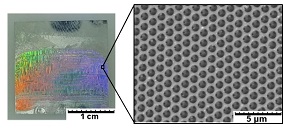 |
| Photograph of a silver coated silica inverse opal (left), fabricated by vertical deposition of colloidal polystyrene suspension (1 μm diameter) and a silica precursor. Sample displays structural colour arising from the periodic micro-structure, observed by SEM micrography (right). |
The main objective of this project is to design and assemble photonic crystal structures based on silica and thermoresponsive poly(N-Isopropylacrylamide) (poly(NIPAM)) hydrogels. Silica inverse opals were fabricated by vertical deposition from polystyrene (PS) colloidal suspensions (240, 500 and 1000 nm) and a silica precursor. The fabricated samples presented angle-dependant coloration. It was found that coating the samples with a thin silver layer (15 nm) can enhance reflection and photonic bandgap tuning by solvent infiltration. Thermoresponsive PCs based on poly(NIPAM) were fabricated by infiltration and polymerization within the PC structure, however the degree of polymerization was low, leading to inconclusive results at this point.
Ellipsoidal lattice structures
 Student: Max Dixon
Student: Max Dixon
Supervisors: Alberto Pirrera, Isaac Chenchiah and Paul Weaver
Nonlinear systems can feature large displacements and variable stiffness, and also some distinctive characteristics such as multiple stable and unstable equilibria. These properties can be exploited to create multifunctional structures, i.e. structures that resist load, while simultaneously fulfilling other unconventional purposes. For example, a structure that is able to deform considerably, transition between stable states with different speeds, or indeed self-actuate or self-assemble, shows functional similarities to a conventional mechanism.
Inspired by the virus Bacteriophage T4 a nonlinear bistable cylindrical structure mimicking the contraction of its tail sheath was designed. The tail sheath is a cylinder comprised of a series of molecular chains arranged as helices around the main axis. The contraction is achieved by altering the pitch of the helices. This mechanism is used by the virus to puncture the outer membrane of the host bacteria and to inject its DNA. We replicated the sheath kinematics with a device comprised of composite helices, forming a cylindrical lattice. By exploiting the interaction/interplay between pre-stress, structural coupling and geometric arrangement multistability is obtained. Furthermore, the structure is highly tailorable, as its stiffness properties, dimensions, and stability characteristics can be chosen to meet a variety of requirements.
This project develops work on the aforementioned cylindrical lattice, by presenting ellipsoidal lattices. It demonstrated that the deformation mechanics and kinematics of multi-stable cylindrical lattices are applicable to alternative geometric configurations with non-zero Gaussian curvature, specifically ellipsoids. Such a lattice is shown to be highly flexible; capable of significantly large deformation without inducing large stresses. The influence of pre-curvature of the individual helices on the geometry and behaviour of the lattice is investigated, with the aim of controlling the lattice shape and deformation. It is shown that the lattice geometry can be manipulated through pre-curvature selection. During deformation the ellipsoidal lattice surface opens and closes to produce a workable internal volume, this novel feature (not found in cylindrical lattices) can be exploited for capture/containment applications at a variety of length scales from encapsulation of medicine at micro scale to satellite debris at macro scale. The ellipsoidal lattice also exhibits tailorable adaptive stiffness, by producing a highly non-linear response to axial displacement. Such behaviour is especially desirable for non-linear springs, energy absorbers and energy harvesters.
Hydrogel actuators: the impact of porosity on power output
 Student: Rob Iredale
Student: Rob Iredale
Supervisors: Charl Faul, Jonathan Rossiter, Ian Bond and Paul Weaver
Previous work within ACCIS has demonstrated that stimuli-responsive hydrogels can be used to drive actuation in biomimetic, light-sensitive composite structures. However, these hydrogels are typically characterised by slow swelling speeds, limited by the rate of water diffusion through the material. This severely hinders their potential application in mechanical actuators. One method to increase the speed of response is to introduce porosity into the material; however, this also results in a decrease in the stresses that the gel can generate. In this study, the effect of different levels of porosity on the swelling speed and force-stroke capability of a pH responsive hydrogel are investigated. Sodium chloride crystals of varying sizes are synthesised and successfully used to produce porous gels via a salt leaching method. A new method for determining hydrogel actuation power is also developed and used to characterise gels of different porosities. It is hoped that this technique can be taken forward to further optimise the microstructure of hydrogels to maximise their actuation potential.
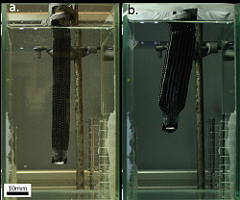 |
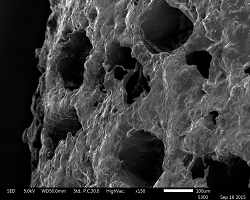 |
| Images of a composite actuator in both the a. unswollen and b. swollen states. | SEM image of a porous hydrogel. |
Effect of Foreign Object Damage on composite aerofoils and structures
 Student: Ashwin Kristnama
Student: Ashwin Kristnama
Supervisors: Michael Wisnom, Stephen Hallett, David Nowell (University of Oxford) and Adam Bishop (Rolls-Royce)
Ingestion of small and hard particles at high speed causes foreign object damage in gas turbine engines. Damage on composite structures may result in premature crack initiation, leading to failure due to harsh operating environment.
|
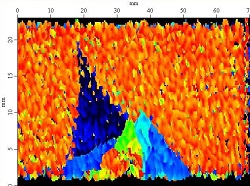 |
| Figure 1: C-scan imaging for laminate hit at an angle to the edge under high speed impact. |
Experimental investigations with carbon-epoxy laminates (IM7/8552) impacted at high and low velocities, using a high-speed gas gun and a spring-based swinging impactor, were conducted. Ultrasonic C-scan showed fibre fracture and delamination, as illustrated in Figure 1. The damage initiation and propagation differ considerably between the two impact loadings. Tensile tests are carried out to determine the influence of variations in thickness, angle and position of impact on the residual strength. The maximum reduction in residual strength occurs for high speed impacts at 45° to the leading edge with a knockdown of 59.8% in strength.
Brittle fracture and pull-out were observed as the main failure mechanisms, shown in Figure 2. However, most low speed impacted laminates failed by brittle fracture at the grips during tensile loading and it was not possible to relate the damage process between the two impact conditions. While extensive modelling techniques, machined notches and effect of notch formation techniques on the specimen integrity were not included, this would be a suitable avenue for further investigation.
 |
| Figure 2: Typical failure mechanisms observed on laminates after tensile tests - (a) pull-out, (b) brittle fracture and (c) brittle fracture and pull-out combination. |
Ray tracing in complex composite geometries using Dijkstra’s algorithm
 Student: Callum Lanherne
Student: Callum Lanherne
Supervisors: Paul Wilcox and Fabrizio Scarpa
Non-destructive testing is an important step in the manufacturing process for any critical components, be it in aerospace, automotive or any number of industries. Ultrasound has been used extensively as a method for investigating the interior of structures for defects. In order to image such components the interior must be sampled, and the arrival times to each point calculated. In isotropic materials, such as aluminium, this is simple; the group velocity does not vary with direction, and so the path can be simply calculated, even in complex shapes such as curves. However when anisotropies are introduced, such as those in composite materials, this becomes less trivial. If a component has a curve, the fibres may follow that curve, so the local coordinate system is no longer translationally invariant. This leads to curved ray paths, and so a straight line calculation is no longer applicable.
Ultrasonic waves obey Fermat's principle - iterating over all possible paths, the path of least time will be the path that the ultrasound follows. Dijkstra's algorithm for shortest network paths then presents itself as a potential solution - by creating a network approximation, it should be possible to find the shortest path based on an anisotropic velocity in an arbitrary shape. This work investigates the validity of Dijkstra's algorithm for this purpose. The aim is to fully characterise Dijkstra's algorithm with respect to network distribution type, nodal density/separation and hop radius. This should enable the creation of a minimum viable product, combining Dijkstra's algorithm with existing imaging algorithms.
Designs of capacitive pressure sensors for wearable device: patterns and sensitivity
 Student: Rujie Sun
Student: Rujie Sun
Supervisors: Jonathan Rossiter and Richard Trask
Wearable electronics are attracting increasing attention as recent advances in materials, mechanics, and manufacturing techniques create new opportunities for the integration of various high-quality electronic and optoelectronic systems into single miniaturized device. The next generation of wearable devices for human physiological information monitoring should be highly flexible, stretchable and sensitive. Pressure sensing is an important function for such devices, and sensing systems are core components to provide reliable feedbacks on body conditions, directly determining the therapy choices.
This research investigates optimisation designs of a capacitive pressure sensor to improve its sensitivity and tactility. The effects of different electrode structures on capacitance are compared to obtain an optimal pattern. Then, based on selected electrode structure, a pyramid dielectric structure is designed to improve pressure sensitivity as well as tactile sensation. And, biocompatible elastomer polydimethylsiloxane (PDMS) is used as the dielectric material. Finally, a sensor array with different dielectric patterns is fabricated and using human skin as the other electrode is demonstrated to be more sensitive to applied displacement.
Towards closed-loop recycling method for aligned short carbon fibre composites
 Student: Rhys Tapper
Student: Rhys Tapper
Supervisors: Kevin Potter, Marco Longana and HaNa Yu
It is becoming increasingly apparent in the composites industry that carbon fibre reinforced polymer (CFRP) usage growth rate is rising each year. From an original aerospace light-weighting commodity, CFRPs have expanded into multiple markets including high-performance vehicles, oil and gas, renewable energy and the mass-manufactured automotive sector. The prevalence of this weight saving agenda is embodied by the current material paradigm shift occurring in the automotive market. Adoption of CFRP material has not been a seamless transition into the automotive market due to substantial barriers. The most influential of these being high carbon fibre (CF) costs and long manufacturing cycles for mass-manufacturing applications. A vehicle's environmental impact is not solely governed by its emissions characteristics but, as CFRPs are adopted, the energy associated with material production carries almost as much of the burden. Materials production impact i.e. material manufacturing and component production waste, is mainly influenced by raw material manufacturing costs which is dominated by the production of CFs. This is not easily optimized as it depends heavily on the price of oil and the CF manufacturing process. Component production waste is an inevitable consequence and can never be fully eradicated therefore a reduction in the environmental penalty of CFs must be provided elsewhere. One route to increasing the desirability of CFRPs is in the recycling of used components and production wastes. As seen previously, it is difficult to reduce the economic and energy costs associated with virgin carbon fibres (vCFs) therefore the development of processes which can utilize these fibres, thus giving them a second lifetime, will serve to decrease their overall environmental impact.
This paper outlines an automated batch process used to manufacture highly aligned, discontinuous carbon fibre preforms. The process is a step towards the development of the first closed-loop recycling method for carbon fibre reinforced thermoplastic composites. Tape type prepregs can be made from carbon fibres with competitive mechanical properties to virgin materials. Prepregs can then be solvent processed resulting in an organic dispersion which is then re-aligned using the automated system. The preforms were made using different thermoplastic solution concentrations and their effects on the material properties of the specimens were evaluated. The work requires some optimization to provide consistency of samples. Despite this the study proved that solvent processing has the potential to enable a closed-loop recycling method for discontinuous carbon fibres and thermoplastic matrix composites.
Development of an atomistic finite element formulation for coupled thermal and piezoelectric properties in nanostructures
 Student: Mat Tolladay
Student: Mat Tolladay
Supervisors: Fabrizio Scarpa and Dmitry Ivanov
Interest in nanotubes and their potential applications has been growing ever since their initial prediction over two decades ago. Concurrently, there has been development of micro, meso and nano scale machines looking to provide new technological capabilities in many different research fields. Components of these miniature machines are an obvious application for nanotubes, however new methods for accurately modelling such machines are required. The standard methods for macro scale modelling rely on the assumptions of continuum mechanics whereas at smaller scales the molecular structure of the materials becomes apparent leading to unacceptable inaccuracies. Although computational chemistry has produced tools for modelling molecular structures they normally require significant computational resources when attempting to model large systems of atoms. In an attempt to overcome this issue a method has been developed that combines aspects from the techniques developed for use in computational chemistry and the methods used for structural analysis that are commonplace in engineering.
The purpose of this work was to expand upon this method by providing a way for calculating properties other than the mechanical properties that have been investigated previously. The focus of this work was on developing a novel method for calculating the piezoelectric response of nanotubes. The ability to capture these effects allows for rapid iterative design development of nano scale electromechanical devices. The culmination of this project was to build and test a model by using it to calculate piezoelectric properties of boron nitride nanotubes and comparing the results to those produced using other methods.
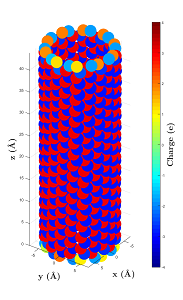 |
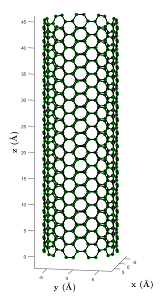 |
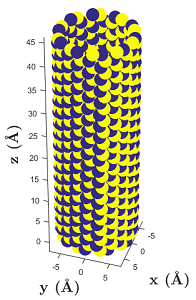 |
Testing and modelling of porosity defects
 Student: Iryna Tretiak
Student: Iryna Tretiak
Supervisors: Luiz Kawashita, Stephen Hallett and Jonathan Taylor (Rolls-Royce)
|
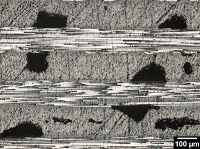 |
|
Optical micrograph showing voids within a composite laminate. |
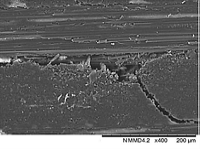 |
|
Scanning electron micrograph of a laminate after ILSS testing, showing cracks emanating from (or propagating through) voids. |
Porosity is a common manufacturing defect in composite materials. It can be caused by ineffective 'debulking' or inadequate autoclave curing cycles, which lead to air being trapped within the laminate. Since the majority of voids are located between the plies, in the interface, a dominant effect on the interlaminar shear strength (ILSS) can be expected. Poor ILSS leads to through-thickness failure, which is the major concern for composite structures. Many researchers have investigated the influence of porosity content on the mechanical performance of composites. However the size, shape, and location of voids are important parameters often not characterised. In this work the UD carbon/epoxy prepreg (Hexcel's IM7/8552) was investigated.
The objectives of this project are as follows:
- To develop a manufacturing method which will allow the fabrication of composite specimens with controlled void content and morphology;
- To investigate the influence of void content/morphology on the ILSS;
- To characterise porosity using micro CT-scanning and to investigate the correlation of various parameters to the observed ILSS;
- To study the influence of voids on crack propagation.
As expected, the strength of the material is reduced with an increase in porosity content. However, it was shown that the location of these voids within the laminate also influences its mechanical properties. The maximum void volume fraction in a ply has so far provided the best correlation with the knockdown in ILSS, performing considerably better than the average void content which is the current industry standard.
Feasibility study on interply lubrication materials improving the quality of drape forming process
 Student: Logan Wang
Student: Logan Wang
Supervisors: Byung Chul (Eric) Kim, Kevin Potter and HaNa Yu
Drape forming is a cost-effective composite thermoforming method that has been used to manufacture large thermosetting composite structures with relatively less complex geometries. This technique improves production rate by laying multiple prepregs to create an uncured laminate first and then forming it into a desired shape later instead of the time consuming direct lay-up process. However, the disadvantage of this method is that out-of-plane wrinkling or fibre buckling occurs during forming, this undesirable defect is mainly generated by the tacky surface resin preventing ply slippage. Therefore, the forming process is usually carried out at an elevated temperature to enhance the ply slippage by reducing the resin viscosity, but the cost of heating energy and processing time can be significant when manufacturing large aircraft components, such as wing spars.
The aim of this project is a feasibility study on promoting prepreg slippage with interleaving lubrication materials during drape forming. This new method has a potential to reduce production costs and enable high-quality complex CFRP parts manufacture. The work includes survey of candidate materials for interply lubrication, and interply frictional resistance measurement with different manufacturing variables.
